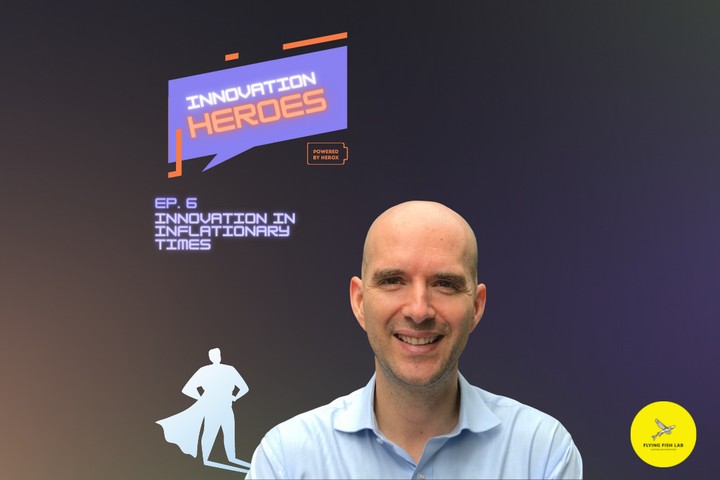
Innovation Heroes Episode.6
The business landscape is changing fast and in dramatic ways. It's time to rewrite the rules, and consider innovation in multiple dimensions. We had the good fortune of connecting with Mário Braz de Matos, Co-founder and Managing Partner at Flying Fish Lab to get his take on #innovation strategies & tools.
Laying the groundwork for #controlleddisruption! We're in an inflationary, uncertain, (possibly) recession scenario - how do you keep growing the business? How do you keep delighting your customers? And how do you keep growing your bottom line? This is the perfect environment to look to productivity innovation for superior results while reducing costs. Laying the groundwork for controlled disruption can be as fascinating as it is impactful.
🔉 Click to listen 👇
What is Controlled Disruption?
We help companies grow. That's at heart of what we do. How we do it is primarily through innovation. What we mean by innovation isn't necessarily only new product development. Innovation to us, in terms of helping companies and businesses grow, goes far beyond that.
It can be from the lens of proposition innovation, you don't have to change the product that you have, perhaps it's the benefit which you are offering consumers that needs to be innovated around. It could be around the way that you do your productivity innovation - how do you add value while lowering costs? (Which seems a contradiction but actually it's a very interesting space). How do we innovate from a communication standpoint? How do we innovate in terms of the way we approach the market?
It's primarily around growth challenges "I need to grow my business", top line or bottom line, and we do that by having this unique approach to controlled disruption, which is fundamentally about asking “how do we leverage the client-side expertise that exists in the category?”.
How do we leverage the client-side expertise that exists in the category?
Typically if you're running a business it is because you know a thing or two about what you're doing, so we're not there to teach you about insurance or paper or shampoo... we're there to bring in something that we call "intelligent naivety". We ask you to question some of the things that you take for granted and interrogate possibilities that you hadn't explored. And by overlaying this intelligent naivety onto your category expertise we succeed in unlocking new possibilities for breakthrough solutions across all these different kinds of growth challenges.
The First Piece: Outside-in
In the "Outside-in" approach, the first piece is to look at the challenges that clients are facing. People are smart, people in every organization are very smart, they're very good, and they're there for a reason. So, if they haven't figured it out - we are Flying Fish Lab are not smarter than they are - they need help to get at the challenge. The way to help these teams is to bring in an "Outside-in" perspective, and that is kind of where HeroX and Flying Fish Lab have done some work together - in crowdsourcing.
Crowdsourcing is possibly the most powerful way to bring in intelligent naivety. And it is naive because the people who help you from the outside are not experts like you. They don't understand your brand and your business as well as you do, that's obvious. But by the same token, they have interest, they have curiosity, and they have their own knowledge. And so when they come to look at your problem, they look at it with this curiosity that leads them to ask these interesting questions that you perhaps no longer ask. And maybe what was true five years ago or ten years ago is no longer true today. So, you might have answered that question in the past, but today they might say, "Hey Adam, have you considered doing this?"
The Kelloggs Example: End-to-end Catalyst to Cross-functional Co-creation
Perhaps to bring this to life in a different way, I'm gonna take an old project with Kellogg's in Australia a few years back working in muesli bars, a perfectly ordinary product in a very commoditized category. What they were looking for were ways to bring to life new plant-based snacks. What the "Outside-in" created was a set of ideas, or possibilities, that were centred around how you could challenge so many of the category conventions; around shape, around the interaction with your food even, around borrowing or stealing category codes from other adjacent categories outside of cereal bars, to bring novelty into the cereal bar space. Then, the work that we did was to push that further and they then have taken that forward into the market. That's just in a nutshell a little example of how that "intelligent naivety" enabled them to unlock possibilities that they wouldn't otherwise have been able to generate by themselves. That was, to a large extent, a contribution that the crowd did in terms of helping open up their minds and then we were able to push and finish that, and bring it to life.
An Aggressive Pressure: No Time to Think
There's an interesting chart recently shared by Professor Scott Galloway on productivity and how it's risen in the U.S. for the last 40 years yet salaries decoupled from it about 20 years ago. What this means is that you're extracting more out of each individual. So, if you've only got a finite number of hours in the day, that means that people are plowing through more work in the same number of hours and what you get with that is less time to go in depth. And so what's happening in this "pressured for results" state is, when you see a tool that seems to promise to solve your problems you jump on it! because you don't have the time to think it through. And it might, or it might not be, the right tool for the problem.
The irony of course is that if you did set aside the time to think through your strategy, to think through what you're trying to achieve, and how to best go about that... the rest actually happens faster. It enables you to move faster on the execution and to the right tools and to go the right way.
I guess that's a little bit of the irony, we find ourselves often with clients who are hoping that these tools can by miracle solve their problems because the pressure on organizations is so big that they seem to not have the time, to afford the time, to spend on strategic thinking and planning, which ironically is more needed the more pressure you have. But I guess human behavior tends to go the other way around.
Cross-pollinating Human Creativity and AI
There's a lot happening right now and I have seen the beginning of AI tools that are able to actually generate creative solutions. There was one particular one (I'm terrible with names) which was a tool used by an architectural firm that fed a number of models and data into the AI tool and it came out with a model for a building. It was an architectural blueprint for building that is built on both data from both architectural principles etcetera, and also nature. This AI tool actually created this quite futuristic and very green sort of building for what the future cities might look like.
When you get that sort of capability, that to me is a really exciting tool to combine with human creativity. I can imagine in the future loads of very interesting possibilities to combine AI and human creativity, perhaps in iterations even. It's super exciting to think about what sort of opportunities these new tools can unlock for us and completely different solutions to what we have today and it's certainly something that excites me personally - to see how technology can complement what we can do as people, as individuals.
Over the years we've been building a base of knowledge of ideas from the crowd. It's one of the projects that we have - to start mining those for richness and depth of insights and for new possibilities. This is based on human creativity then seeing how AI can further multiply that cross-pollinating new ideas out of that. That's something that we have in the plans, still early days, but it's one of the interesting possibilities we're exploring.
Deliver Superior Results while Reducing Costs
You start by looking at the problem differently, I wouldn't worry so much about the tools, but rather what is the challenge? And the challenge is, "We're in an inflationary, uncertain, possibly recession, scenario as how do we keep growing the business? How do you keep delighting your customers? And how do you keep growing your bottom line?"
The answer then requires a fresh perspective and that would be the perfect environment where you should be looking at productivity innovation which is about, "How might an organization go about delivering superior results and benefits to customers while reducing costs at the same time."
It's harder, it's definitely harder to do than just coming up with something that pleases consumers and delights consumers in some amply open way because 'anything is possible as long as my customers are here', and you're looking at a very narrow space, but creativity is about constraints. We've been able to unlock incredible amounts of resources and basically gigantic savings while delivering from a consumer perspective products that are clearly above, or at least a parity to, where they are today. If you can delight your customer and you can increase your margin, that seems to me the sort of challenge that makes sense in these recessionary or inflationary times because you're basically continuing to win over your customer and at the same time you're enabling the company to sail through these stormy times.
Shifting Proposition: Johnson & Johnson
Productivity is a particular kind of challenge that typically makes more sense when you look at the entire end-to-end offering because if you look at one part it impacts upstream and downstream. You might be saving a lot of money in warehousing but spending more than that because you're buying the wrong product, or you're losing money in you're sourcing. So that's an area where it makes more sense to look at it in an integral way, because you have to.
Whereas if it's perhaps a proposition innovation what you're really looking at is, "How might my existing product give consumers a new benefit?". The very decades-old classic is the Johnson & Johnson baby shampoo where J&J just went, "Actually, it's so gentle that even Mom can use it" and all of a sudden instead of being a shampoo for babies, it's a shampoo for the whole family. You just quadrupled the potential volume there. That's a very old and very basic and brilliant example of proposition innovation that doesn't require you to look at the supply chain, that doesn't require you to look at the packaging even, you're literally selling the same product for a different reason, and there's tons of examples out there.
The Future is Hybrid
Not just from a work perspective, but also an innovation one. When it comes to tech and people, tools and strategy, I don't think you'll be able to take sides and say, "the answer is only strategy or the answer is only tools or the answer is only tech or it's only people," you're going to have to combine everything to reach the speed and the momentum of innovation that I think customers and consumers are going to expect from organizations.
Thank you for checking out Episode #6 of the Innovation Heroes series!
Let's keep the conversation going! Interested in chatting with Adam on an Innovation Heroes segment or recommending a guest? To join the queue, send an email to Attn: Adam. Include your name, email, and topic of interest (you can also use the HeroX contact form).
About Mário Braz de Matos | Connect
Mário is the Co-founder and Managing Partner at Flying Fish Lab, a Singapore-based open innovation consultancy which focuses on delivering Controlled Disruption™ for brands by reframing their challenges through an "intelligently naive" perspective. They combine next gen crowdsourcing with challenger thinking and business greenhousing to create disruptive solutions across innovation, products, activation, communication and brand positioning. Flying Fish Lab helps businesses grow through innovative new solutions.
Connect with Mário: LinkedIn, , How to Implement Ideas

🔉 About the Innovation Heroes podcast
The Innovation Heroes series covers all things open innovation, crowdsourcing, and remote work. It’s time to open up the airways, share strategies, engage partners, and leverage the power of crowd intelligence to expedite solutions to the pressing problems facing every level of organization, individuals, and the world. The key word here is OPEN.
We're bringing our partners in innovation, organizations who have run their own crowdsourcing projects, innovator powerhouses, and remote work legends into the spotlight. There is a global network ready to contribute time, energy and intelligence to just about any challenge that comes their way. All we need to do is provide the opportunity. Thank you for being a part of the solution. Discover the Power of the Crowd
About Adam Olsen | Connect
Adam is your Podcast Host and Possibilities Manager at HeroX, connecting with innovation leaders from around the world to gain insights on how they approach innovation, the technologies they're most excited about, and how these innovations impact their industries.
HeroX is a platform and open marketplace for crowdsourcing innovation that allows anyone, anywhere, to solve everyday business and world challenges using the power of the crowd.
Connect with Adam: LinkedIn,
#innovation #controlleddisruption #crowdsourcing #flyingfishlab #HeroX
Your Crowd. Your Solution.








